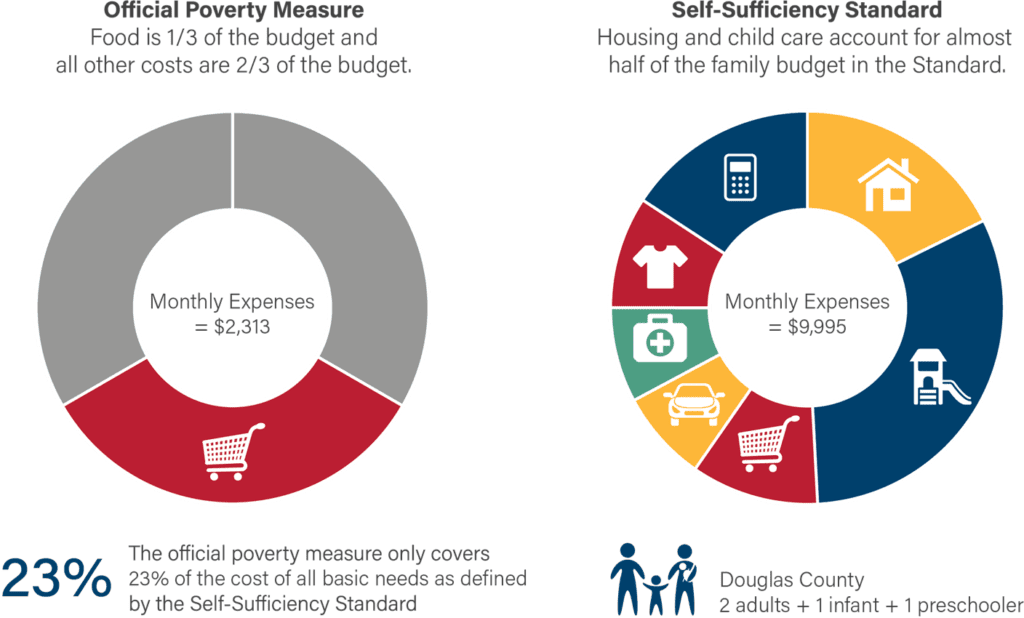A summary of the list of recommendations on the implementation of the OBBBA in Colorado regarding public benefits systems and work requirements.
Recent articles
CCLP testifies in support of Colorado’s AI Sunshine Act
Charles Brennan provided testimony in support of Senate Bill 25B-004, Increase Transparency for Algorithmic Systems, during the 2025 Special Session. CCLP is in support of SB25B-004.
Coloradans launch 2026 ballot push for graduated state income tax
New ballot measure proposals would cut taxes for 98 percent of Coloradans, raise revenue to address budget crisis.
CCLP statement on the executive order and Colorado’s endless budget catastrophe
Coloradans deserve better than the artificial budget crisis that led to today's crippling cuts by Governor Jared Polis.
Reintroducing the Self-Sufficiency Standard

Although it is the primary metric used in the United States to evaluate economic need, the official poverty measure no longer provides an accurate picture of what households need to support themselves and their families. At best, the poverty rate gives us a picture of who is struggling the most to make ends meet. We know this by looking at an alternative approach to measuring economic security, known as the Self-Sufficiency Standard.
The Standard takes what is known as a basic needs budget approach—in other words, it estimates a household’s costs across seven different areas (housing, child care, food, transportation, health care, miscellaneous expenses, and tax, minus tax credits) and adds up those costs to arrive at the hourly, monthly, or annual income needed in order for the household to cover all of these expenses. What also sets the Self-Sufficiency Standard apart from the official poverty measure is that it assumes different costs for different families — both by the age and number of household members, and by the county in which a household lives. This granularity gives us much more accurate estimates that reflect the actual costs of basic needs and variations in cost of living across Colorado. In contrast, the official poverty measure simply assumes basic needs are three times the cost of food, and that those costs are uniform across the state.
Comparing the monthly income needs arrived at by the official poverty measure and the Self-Sufficiency Standard for a family of 2 adults, 1 infant, and 1 preschooler living in Douglas County in 2022 illustrates just how different these approaches are—as are the stories they tell about economic insecurity in Colorado.
The OPM estimates this family would need $2,313 in monthly income to meet their needs—the Self-Sufficiency Standard estimates the monthly income needs of this family would be $9,995 that same year. In other words, a poverty wage for this household would only allow them to cover 23% of their monthly income needs as estimated by the Self-Sufficiency Standard. Indeed, a poverty wage would just barely allow this family to afford the cost of child care or housing and would leave no money left over for other expenses. In 2019, 24.9% of Colorado households with at least one adult between the ages of 18 and 64 with no work-limiting disability had incomes below the Self-Sufficiency Standard for their household type and county. On the other hand, 7.4% of households had incomes below the official poverty measure that same year.
The Self-Sufficiency Standard estimates the income needed by households without assistance from public benefit programs, such as Medicaid or the Supplemental Nutrition Assistance Program (SNAP). In reality, these work support programs can play an important role in helping Colorado families meet their basic needs. For example, a household consisting of one adult, one preschooler, and one school-age child would need to earn $5,477 per month to cover their basic needs living in Pueblo County. With the support of a suite of work supports and public programs, the income needed by this family can be reduced to $2,590 per month, a much more attainable expectation for a single income household.
However, these work supports are not available to all who need them. Since most programs use the official poverty measure to determine eligibility, households which may not earn enough to cover their expenses might also not be eligible for the program that would help them cover those expenses. In other cases, enrollment in a program, like the Housing Choice Voucher program, is limited by program funding. The Self-Sufficiency Standard illustrates how a robust and efficient public support program can be an invaluable resource for helping families move to self-sufficiency—and how a meager and inefficient system can fail those same families.
Since 2001, Colorado Center on Law and Policy has been fortunate to be able to work with the University of Washington, the stewards of the Self-Sufficiency Standard, to publish income need estimates for Colorado. With nearly two decades worth of data, we can look back to see how income needs have changed in Colorado relative to other measures, such as inflation or median earnings. Since 2001, a household consisting of two adults, one preschooler, and one school-aged child has seen their income needs increase by an average of 124% (when averaged across all counties in Colorado). Health care and child care costs outpaced other costs, increasing by 176% and 139%, respectively between 2001 and 2022. Notably, median earnings for workers in Colorado increased by 64% over this same period, meaning that households have seen costs increase faster than incomes. This was true even before the period of high inflation we’ve experienced over the past two years.
A lot has changed in Colorado since 2018, and we are pleased to be able to release an update to the report after more than two years of tremendous economic and social disruption. As we continue our recovery from the COVID-19 pandemic and navigate the economic challenges that have arisen since, it is fundamental to understand Coloradans’ income needs that is grounded in the actual costs facing our families. Not only does the latest SSS report give us a more realistic picture of who is struggling to make ends meet, it also allows us to understand how costs have changed over time, and where we might intervene with policies or programs to support Coloradans in their journey to self-sufficiency. We hope that this report will serve as a resource for the entire anti-poverty movement in Colorado and look forward to partnering with or assisting any groups or organizations that are interested in learning more about the Self-Sufficiency Standard and how it can be used as a tool to advance economic security for all Coloradans.
Click here to download the Self-Sufficiency Standard report.

